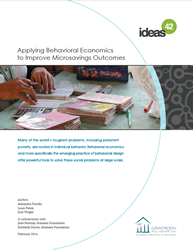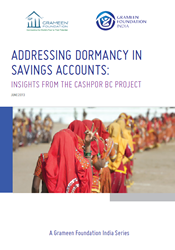Using Behavioral Economics to Create New Savings Habits
March 24, 2014
By Kimberly Davies, Program Officer, Financial Services

You’ve finally gotten that new savings product off the ground and into people’s hands. They sign up in droves—and then they go silent.


 Many of the world’s toughest problems, including persistent poverty, are rooted in individual behavior. Behavioral economics and more specifically the emerging practice of behavioral design offer powerful tools to solve these social problems at large scale. Behavioral design applies insights from decades of academic research in behavioral economics and behavioral psychology to develop low-cost interventions with large effects.
Many of the world’s toughest problems, including persistent poverty, are rooted in individual behavior. Behavioral economics and more specifically the emerging practice of behavioral design offer powerful tools to solve these social problems at large scale. Behavioral design applies insights from decades of academic research in behavioral economics and behavioral psychology to develop low-cost interventions with large effects.
 It is estimated that at a country level in India, a mere 20% or less of the 100 million savings accounts opened so far are active and the rest 80% of the accounts become dormant. Dormancy is a concern as it indicates that the newly banked are not using their accounts and therefore are not effectively leveraging opportunities to climb out of poverty.
It is estimated that at a country level in India, a mere 20% or less of the 100 million savings accounts opened so far are active and the rest 80% of the accounts become dormant. Dormancy is a concern as it indicates that the newly banked are not using their accounts and therefore are not effectively leveraging opportunities to climb out of poverty. Prevailing wisdom holds that the ultra-poor are too poor to save money. This study examines the savings behavior of ultra-poor women served by the Livelihood Pathways for the Poorest project, which is jointly implemented by Grameen Foundation and the Livelihood School (part of BASIX group of companies), in Gaya District, Bihar, India.
Prevailing wisdom holds that the ultra-poor are too poor to save money. This study examines the savings behavior of ultra-poor women served by the Livelihood Pathways for the Poorest project, which is jointly implemented by Grameen Foundation and the Livelihood School (part of BASIX group of companies), in Gaya District, Bihar, India. The mobile phone is gaining widespread popularity as a means to bridge the “last mile” – to bring information and financial services to people without ready access to them. To get a better picture of how to best deliver mobile services, we conducted a case study with our partner, Cashpor Microcredit, based in Varanasi, India.
The mobile phone is gaining widespread popularity as a means to bridge the “last mile” – to bring information and financial services to people without ready access to them. To get a better picture of how to best deliver mobile services, we conducted a case study with our partner, Cashpor Microcredit, based in Varanasi, India. This case study presents work done with CARD Bank in the Philippines as part of a larger savings mobilization project with Grameen Foundation to introduce a new type of savings product and expand CARD’s market share to poor savings clients.
This case study presents work done with CARD Bank in the Philippines as part of a larger savings mobilization project with Grameen Foundation to introduce a new type of savings product and expand CARD’s market share to poor savings clients. For over 30 years, microfinance institutions (MFIs) have been successfully serving some of the poor and poorest people around the world, primarily with credit products. Generally however, MFIs grapple to successfully add savings services to their portfolio of financial products.
For over 30 years, microfinance institutions (MFIs) have been successfully serving some of the poor and poorest people around the world, primarily with credit products. Generally however, MFIs grapple to successfully add savings services to their portfolio of financial products.